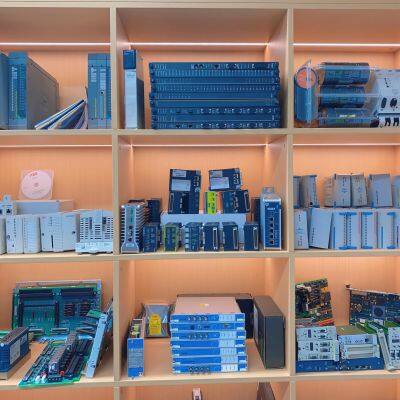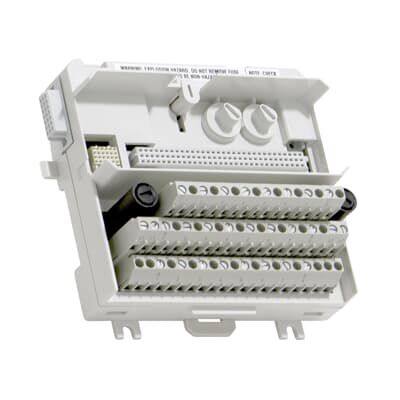Product Description
I. Overview
ABB TU839 3BSE046966R1 is a controller base module, a core hardware support unit of the AC 800M series distributed control system. It is specifically designed to meet the requirements of controller module installation, signal transfer, and power distribution in medium and large-scale industrial process control scenarios. Adopting a standardized modular structure and high-reliability connection design, this base integrates core functions such as multi-channel signal transfer, stable power distribution, modular installation and positioning, and comprehensive electromagnetic compatibility protection. It provides stable mechanical support and efficient signal transmission links for AC 800M series controllers (such as PM861, PM864, etc.).
As a key connection hub between the controller module and the backplane bus in the AC 800M control system, ABB TU839 3BSE046966R1 features excellent system compatibility and expansion flexibility. It can seamlessly adapt to all specifications of AC 800M series controller modules and related expansion modules, and support collaborative work with ABB Process Portal configuration software, HMI human-machine interaction platforms, distributed IO modules (such as AI810, AO810), and upper monitoring systems (SCADA/MES). It is widely used in complex industrial fields such as chemical engineering, petroleum and petrochemical, electric power, metallurgy, and papermaking, providing a solid hardware foundation for the control logic operation, multi-dimensional signal interaction, and stable system operation and maintenance of key equipment such as large-scale reaction devices, generator sets, and production lines. With advantages including high mechanical strength, low contact impedance, strong environmental adaptability, and long service life, this base can adapt to harsh industrial environments such as high temperature, high humidity, heavy dust, and strong electromagnetic interference, ensuring the continuous and stable operation of the core units of the control system.
II. Core Functional Features
ABB TU839 3BSE046966R1 is highly compatible with the architectural design requirements of the AC 800M series control system. Integrating ABB's mature experience in the field of industrial connection technology, it has the following core functional features:
Standardized Modular Installation and Positioning: It adopts the standard rack-mounted installation dimensions of the AC 800M series, supporting direct integration into standard 19-inch industrial cabinets and ABB dedicated control cabinets. Through the precise cooperation between the bottom buckle and the cabinet guide rail, quick positioning and installation are achieved, with the installation error controlled within ±0.5mm to ensure perfect fit between the controller module and the base. The top of the base is designed with dedicated guide posts and positioning slots, enabling blind-mate installation of the controller module. During insertion, positional deviations are automatically corrected to avoid pin damage caused by misalignment. After the module is installed, it is reinforced with side locking screws, capable of withstanding vibration shocks of 5-1000Hz and 2g acceleration, ensuring connection stability in vibrating environments such as metallurgical workshops and near large fans.
Efficient Signal Transfer and Bus Communication: It has 2 built-in groups of high-speed backplane bus interfaces, compatible with the ABB proprietary bus protocol. It supports bidirectional high-speed data transmission between the controller module, IO expansion modules, and communication modules, with a maximum bus transmission rate of 100Mbps and a data transmission delay of ≤1ms, meeting the strict real-time requirements of medium and large-scale industrial control scenarios. The base integrates high-density gold-plated pins (120 pins in total) with a pin pitch of 2.54mm, adopting a crimping connection process, and the contact impedance is ≤50mΩ, effectively reducing signal transmission loss. The pin area is equipped with a dust-proof cover that automatically closes when no module is installed, preventing poor contact caused by dust and moisture intrusion. Meanwhile, clear pin definition marks are labeled on the cover for easy on-site debugging and maintenance.
Stable Power Distribution and Overload Protection: It is equipped with two independent power input interfaces (DC 24V±10%), supporting main-standby redundant power configuration. The input voltage range covers 19.2-26.4V DC, which can be adapted to common DC power supply systems in industrial sites. A high-precision power distribution circuit is integrated inside to stably distribute the input power to the core power supply terminal, logic power supply terminal, and standby power supply terminal of the controller module. The output voltage ripple is ≤50mV, ensuring the stable operation of each circuit unit of the controller module. The power supply circuit is built with a self-recovering fuse (rated current 3A) and an overvoltage protection diode (protection threshold 28V). When an overload or overvoltage fault occurs, the power supply can be quickly cut off and current limited automatically within 5ms, and the power supply can be restored within 100ms after the fault is eliminated, effectively protecting the controller module and the internal circuit of the base from damage.
Comprehensive Electromagnetic Compatibility and Environmental Adaptability: It adopts an all-metal shielded housing made of high-strength cold-rolled steel plate. The surface undergoes double anti-rust treatment of galvanization and plastic spraying, with an IP20 protection level, which can effectively shield external electromagnetic interference (EMI) and prevent internal signal leakage. The internal signal lines adopt a twisted-pair layout and are wrapped with a shielding layer, achieving physical isolation from the power supply lines with an isolation distance of ≥5mm. It can resist ±2kV electrostatic discharge, ±1kV surge impact, and 80MHz-1GHz radiated interference, fully complying with the IEC 61000-4 series of electromagnetic compatibility standards. Industrial-grade components with a wide temperature range are selected, with an operating temperature range of -20℃~60℃, a storage temperature range of -40℃~85℃, and a relative humidity adaptation range of 5%-95% (no condensation), which can be adapted to extreme environments such as high-temperature chemical workshops and outdoor control cabinets.
Convenient Operation & Maintenance and Status Monitoring: The front of the base is equipped with 3 LED status indicators, corresponding to "Power Status" (steady green indicates normal power supply, blinking indicates redundant switching, and off indicates power failure), "Bus Communication" (steady green indicates normal communication, blinking indicates data transmission, and steady red indicates communication failure), and "Module Connection" (steady green indicates the module is properly installed and in good contact, and steady red indicates the module is not installed or in poor contact) respectively. The operating status of the base and the controller module can be quickly determined through the combination of indicators. The side of the base is designed with fault diagnosis test points, through which key parameters such as power supply voltage and bus signal strength can be directly measured with special test instruments, enabling fault troubleshooting without disassembling the module. At the same time, a label pasting area is reserved for easy on-site marking of module numbers, installation locations, maintenance records, and other information.
Flexible Expansion and System Compatibility: It supports seamless adaptation to all specifications of AC 800M series controller modules (such as PM860, PM861, PM864, PM865, etc.). By replacing controller modules of different models, flexible upgrading of control scale and functions can be achieved without replacing the base or rewiring, greatly reducing system expansion costs. It is compatible with various ABB expansion modules (such as communication module CI854, IO interface module AI810, etc.). Through the backplane bus, cascade expansion of up to 32 expansion modules can be realized, supporting flexible configuration of control points from 128 points to 2048 points. It can perfectly collaborate with ABB Process Portal configuration software and Control Builder M programming software, supporting online programming, parameter configuration, and firmware upgrading of the controller module. During the upgrading process, the base can stably maintain power supply and signal transmission, ensuring uninterrupted system operation.

III. Detailed Technical Parameters
IV. Working Principle
As a core support unit of the AC 800M series controller, the working principle of ABB TU839 3BSE046966R1 revolves around four core links: "power distribution - signal transfer - status monitoring - redundancy protection", realizing the efficient collaborative operation of the controller module and other system units. The specific working principle is as follows:
Redundant Power Distribution Link:Dual-channel DC 24V redundant power supplies in the industrial site are connected to the "POWER IN 1" and "POWER IN 2" interfaces of the base through special shielded cables. The input power first passes through a reverse connection protection diode to prevent circuit damage caused by reverse connection of the power supply's positive and negative poles. Then it enters the voltage detection circuit to monitor the amplitude and stability of the two input voltages in real-time. When both voltages are within the range of 19.2-26.4V DC, the power supply switching circuit automatically selects the channel with the higher voltage as the main power supply and the other as the standby power supply. The main and standby power supplies are isolated by a diode to avoid mutual interference of loop currents. When the main power supply voltage is lower than 19.2V or higher than 26.4V, the switching circuit quickly switches to the standby power supply within 1ms to ensure the continuity of power supply.
The stable power supply after switching enters the power distribution circuit, and through high-precision linear regulators, it outputs the core power required by the controller module (such as 3.3V DC logic power supply, 5V DC interface power supply) respectively. The output voltage ripple is controlled within 50mV through a capacitor filter circuit, providing stable power supply guarantee for the core units of the controller module, such as CPU, memory, and interface circuits. The self-recovering fuse in the power supply circuit monitors the output current in real-time. When the current exceeds 3A, the fuse automatically blows and limits the current within 5ms to avoid circuit burnout caused by overload. After the fault is eliminated, the fuse automatically resumes conduction within 100ms to restore normal power supply.
High-Speed Signal Transfer Link:After the controller module is accurately docked with the base's positioning slots through the top guide posts, the pins at the bottom of the module are fully in contact with the 120-pin gold-plated pin socket of the base, forming a stable mechanical and electrical connection. The control signals and data signals generated by the core units of the controller module (such as CPU and memory) are transmitted to the signal transfer circuit inside the base through the pins. The transfer circuit adopts a differential signal transmission design, converting single-ended signals into differential signals to effectively suppress common-mode interference during transmission.
The differential signals are transmitted to the system backplane bus through the backplane bus interface built in the base, realizing data interaction with other units such as IO expansion modules and communication modules: on the one hand, the control commands generated by the controller are sent to each IO module to drive the action of on-site actuators; on the other hand, the industrial on-site sensor signals (such as temperature, pressure, flow rate, etc.) collected by the IO modules are received and transmitted to the controller module for calculation and processing. At the same time, the signal isolation circuit inside the base achieves physical isolation between the power supply lines and signal lines, with an isolation resistance of ≥100MΩ and an isolation voltage of ≥1kV AC, preventing interference signals from the power supply circuit from entering the signal link and ensuring the integrity and reliability of signal transmission.
Real-Time Status Monitoring Link:The status monitoring circuit built in the base collects three key parameters in real-time: first, the two input voltages and the distributed output voltages are collected through voltage sensors, and the voltage data is converted into digital signals and transmitted to the indicator light drive circuit; second, the signal amplitude, transmission rate, and bit error rate of the backplane bus are monitored through the bus signal detection circuit to determine the bus communication status; third, the installation status of the controller module is detected through mechanical contact sensors. When the module is fully inserted and locked, the contacts close to generate a "module in place" signal.
The indicator light drive circuit controls the three LED indicators on the front according to the collected status data: when the main power supply is normal, the "POWER" light is steady green; when switching between main and standby power supplies, the "POWER" light blinks green; when both power supplies fail, the "POWER" light is off. When the bus communication is normal and there is no data transmission, the "BUS" light is steady green; when there is data transmission, the "BUS" light blinks green; when the bus bit error rate exceeds 1% or communication is interrupted, the "BUS" light is steady red. When the controller module is properly installed and in good contact, the "MODULE" light is steady green; when the module is not installed or the pins are in poor contact, the "MODULE" light is steady red, providing intuitive status guidance for operation and maintenance personnel.
Redundancy Protection and Fault Isolation Link:In the dual-base redundant configuration scenario, two TU807 bases are connected through a dedicated synchronization cable to synchronize the power supply status, bus communication status, and module operation status of the two bases in real-time. When the power supply of the main base fails or the bus communication is interrupted, the standby base quickly detects the abnormality through the synchronization signal, and under the collaborative control of the controller module, seamless switching of the control logic is realized to ensure uninterrupted system control.
The fault isolation circuit inside the base isolates the controller module from external signals through photoelectric isolation technology. When external IO modules or communication modules have faults such as overvoltage or short circuit, the isolation circuit can effectively block the transmission of fault signals to the controller module, avoiding controller damage caused by fault spread. At the same time, the fault detection circuit transmits fault information to the controller module through the bus, and the controller uploads fault alarm information through the ABB Process Portal software, facilitating timely troubleshooting by operation and maintenance personnel.


ABB AI815 3BSE052604R1 Analog Input HART 8 ch
ABB AO820 3BSE008546R1 Analog Output 4 ch
ABB AO895 3BSC690087R1 Analog Output IS HART 8 ch
ABB AO845 3BSE023676R1 Analog Output Module
ABB AO650 3BHT300051R1 Analog Output 8ch, 12bit Chan Isol
ABB AO890 3BSC690072R1 Analog Output IS 8 ch
ABB SB821 3BSE018109R1 Battery Unit
ABB SS822 3BSC610042R1 Voting Device
ABB SS832 3BSC610068R1 Power Voting Unit
ABB PL810 3BDH000311R0101 Programmable Controller Module
ABB PL890 3BDH003115R0101 Programmable Controller Module
ABB DO810 3BSE008510R1 Digital Output 24V 16 ch
ABB DO890 3BSC690074R1 Digital Output IS 4 ch
ABB DO840 3BSE020838R1 Digital Output 24V S/R 16 ch
ABB DO820 3BSE008514R1 Digital Output Relay 8 ch
ABB DO814 3BUR001455R1 Digital Output Current 16 ch
ABB 87TS01 GJR2368900R1550 Coupl.Mod. CDS Slave M
ABB 87TS01 GJR2368900R2550 Control Board
ABB 81ET03 GJR2389800R1210 Input Module Temp. Sensors
ABB 81AB03-E GJR2392500R121 Molded Case Circuit Breaker of Tmax T4 Series
ABB DI810 3BSE008508R1 Digital Input Module
ABB DI820 3BSE008512R1 Digital Input 120V A.c. 8 ch
ABB DI818 3BSE069052R1 Digital Input 24V 32 ch
ABB DI825 3BSE036373R1 Digital Input 125V SOE 8 ch
 yezi
Hi there! Welcome to my shop. Let me know if you have any questions.
yezi
Hi there! Welcome to my shop. Let me know if you have any questions.


